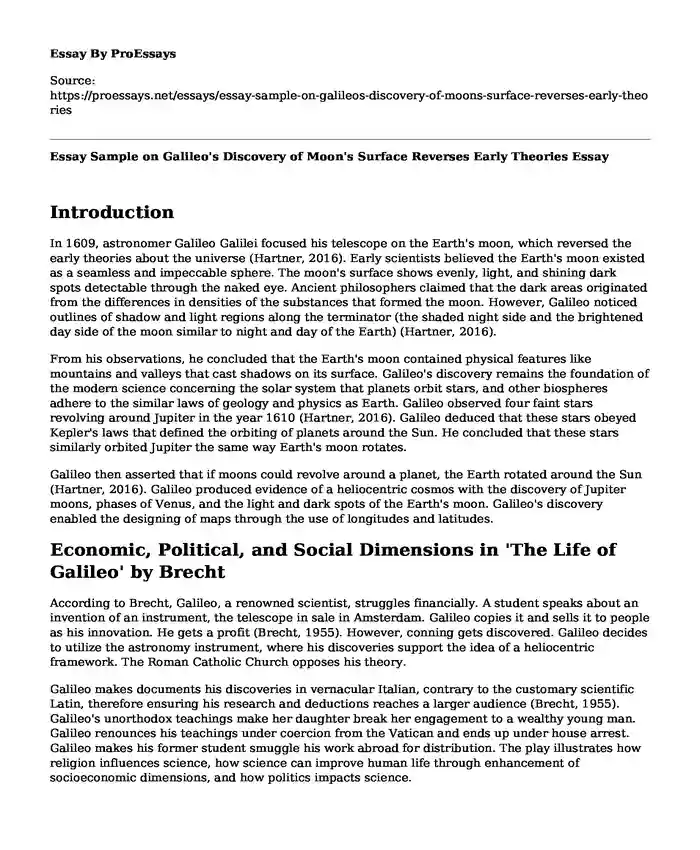Introduction
In 1609, astronomer Galileo Galilei focused his telescope on the Earth's moon, which reversed the early theories about the universe (Hartner, 2016). Early scientists believed the Earth's moon existed as a seamless and impeccable sphere. The moon's surface shows evenly, light, and shining dark spots detectable through the naked eye. Ancient philosophers claimed that the dark areas originated from the differences in densities of the substances that formed the moon. However, Galileo noticed outlines of shadow and light regions along the terminator (the shaded night side and the brightened day side of the moon similar to night and day of the Earth) (Hartner, 2016).
From his observations, he concluded that the Earth's moon contained physical features like mountains and valleys that cast shadows on its surface. Galileo's discovery remains the foundation of the modern science concerning the solar system that planets orbit stars, and other biospheres adhere to the similar laws of geology and physics as Earth. Galileo observed four faint stars revolving around Jupiter in the year 1610 (Hartner, 2016). Galileo deduced that these stars obeyed Kepler's laws that defined the orbiting of planets around the Sun. He concluded that these stars similarly orbited Jupiter the same way Earth's moon rotates.
Galileo then asserted that if moons could revolve around a planet, the Earth rotated around the Sun (Hartner, 2016). Galileo produced evidence of a heliocentric cosmos with the discovery of Jupiter moons, phases of Venus, and the light and dark spots of the Earth's moon. Galileo's discovery enabled the designing of maps through the use of longitudes and latitudes.
Economic, Political, and Social Dimensions in 'The Life of Galileo' by Brecht
According to Brecht, Galileo, a renowned scientist, struggles financially. A student speaks about an invention of an instrument, the telescope in sale in Amsterdam. Galileo copies it and sells it to people as his innovation. He gets a profit (Brecht, 1955). However, conning gets discovered. Galileo decides to utilize the astronomy instrument, where his discoveries support the idea of a heliocentric framework. The Roman Catholic Church opposes his theory.
Galileo makes documents his discoveries in vernacular Italian, contrary to the customary scientific Latin, therefore ensuring his research and deductions reaches a larger audience (Brecht, 1955). Galileo's unorthodox teachings make her daughter break her engagement to a wealthy young man. Galileo renounces his teachings under coercion from the Vatican and ends up under house arrest. Galileo makes his former student smuggle his work abroad for distribution. The play illustrates how religion influences science, how science can improve human life through enhancement of socioeconomic dimensions, and how politics impacts science.
The Copernican Revolution and the Relations of Humans with the World
The Copernican Revolution refers to the model move from the Ptolemaic theory of the heavens, which denoted the universe as having Earth fixed in the middle of the world, to the heliocentric structure with the Sun at the core of the Solar System (Sharma, 2018). The Copernican approach suggests the physical reality of the universe, an idea that the Ptolemaic theory could not offer. The theories by Copernicus made several people, especially the Church, uncomfortable and troubled.
Copernicus detached Earth from the epicenter of the cosmos, placed the heavenly objects in revolution around the Sun, and presented the Earth's normal cycle on its axis. Copernican Revolution affects the way that people reason in that the mind has contains an active duty in generating people's notion of reality by acting like a sieve, manager, and enhancer (Sharma, 2018). The ability to change mere assumptions through evidence no matter the opposition remains ideal in understanding human relations with the rest of the world in which humans inhabit.
Conclusion
Galileo's discoveries and contributions in various fields like mathematics, physics, philosophy, and astronomy revolutionized and laid a foundation for modern science. However, his controversial approaches, which influenced how people view and appreciate the solar system and humans' place within the cosmos, created a severe fight with the Roman Catholic Church and the prolonged subdual of his accomplishment.
References
Brecht, B. (1955). Life of Galileo. Hick Smith. www.learn.stleonards.vic.edu.au/vceeng/files/2013/11/Life-of-Galileo-by-Brecht.pdf
Hartner, W. (2016). Galileo's contribution to astronomy. Vistas in Astronomy: Volume 11, 11, 31. www.books.google.com/books
Sharma, N. (2018). Contextualizing Immanuel Kant’s views on enlightenment in Bertolt Brecht’s ‘Life of Galileo’. www.the-criterion.com/V9/n1/GL01.pdf
Cite this page
Essay Sample on Galileo's Discovery of Moon's Surface Reverses Early Theories. (2023, Sep 25). Retrieved from https://proessays.net/essays/essay-sample-on-galileos-discovery-of-moons-surface-reverses-early-theories
If you are the original author of this essay and no longer wish to have it published on the ProEssays website, please click below to request its removal:
- Euler and the Function Concept and Philosophy of Mathematics Essay
- Understanding Social Theory: Explaining Human Interactions & Forming Hypotheses - Essay Sample
- Essay on Heteropatriarchy & Settler Colonization: The Social-Economic Impact
- Essay Example on Hitler and Nazis: Racist Worldview and Anti-Semitism
- Essay on Cold War & Rocky Films: U.S Propaganda Through Cinema
- Shenzhen: Landscape, Flora, Fauna & Geology - Essay Sample
- Secession: Causes of the 1860s U.S. Civil War - Essay Sample







